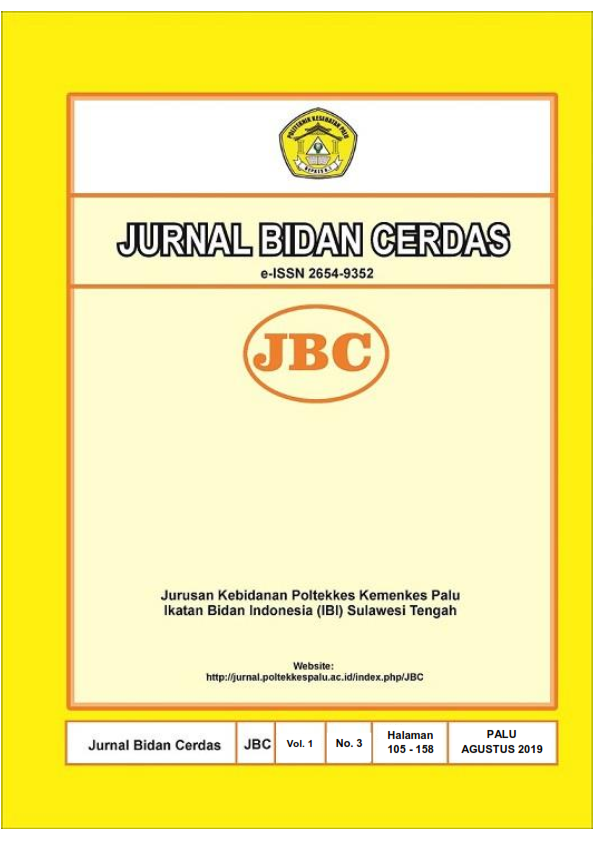Hubungan Gaya Belajar dengan Indeks Prestasi Semester Mahasiswa Prodi DIV Jurusan Kebidanan di Poltekkes Kemenkes Palu
Keywords:
learning styles, learniGrade Point Average (GPA)Abstract
Every student has a different way of understanding and obtaning information. These differences can be influenced by learning styles. The calculation results based on the Grade Point Avarage (GPA) of the third-grade DIV Midwifery students showed that the GPA in each semester fluctuate, and the result of interviews most students used the method of learning with the rote system. This study was intended to know the correlation between learning styles with the GPA of the students. This study used an analytical survey method with a cross-sectional approach a stratified random sampling technique with 42 respondents, data analysis were done in univariate and bivariate using chi-square test. The results of the statistical test shows that the correlation between learning styles with the GPA was p-value 0,459. The most used learning style by respondents was auditory. The GPA category most owned by respondents was GPA ranges between 2,75 – 3,50 which was equal to 90,5%. The conclusion is that there was no correlation between of learning styles with GPA.
Downloads
References
Kementerian Kesehatan R.I. Kurikulum Inti Diploma IV Kebidanan. Jakarta: Badan pengembangan dan Pemberdayaan SDM Kesehatan; 2014.
Abbas Pourhossein Gilakjani, Ahmadi SM. The Effect of Visual , Auditory , and Kinaesthetic Learning Styles on Language Teaching. In: International Conferences on Social Science and Huminity. 2011. hal. 469–72.
Syofyan R, Siwi MK. The Impact of Visual, Auditory, and Kinesthetic Learning Styles on Economics Education Teaching. In: 1st International Conference On Economics Education, Economics, Business and Management, Accounting and Entrepreneurship. 2018. hal. 642–9.
Porter B, Hernacki M. Quantum Learning: Membiasakan Belajar Nyaman dan Menyenangkan. Bandung: Kaifa; 2014.
Wulandari R. Hubungan Gaya Belajar dengan Prestasi Belajar Mahasiswa Prodi DIV Kebidanan. [Surakarta]: Prodi DIV Kebidanan Universitas Sebelas Maret; 2011.
Rahmawati E. Hubungan Gaya Belajar dengan Pencapaian Indeks Prestasi Kumulatif Mahasiswa Fakultas Kedokteran. [Lampung]: Fakultas Kedokteran Universitas Lampung; 2016.
Subini R. Mengatasi Kesulitan Belajar pada Anak. Jogjakarta: Javalitera; 2017.
Hardiansyah. Pengaruh Gaya Belajar terhadap Prestasi Belajar Akademik Mahasiswa Fakultas Kedokteran Universitas Diponegoro. [Semarang]: Fakultas Kedokteran Universitas Diponegoro; 2014.
Published
How to Cite
Issue
Section
Copyright (c) 2019 Author

This work is licensed under a Creative Commons Attribution-ShareAlike 4.0 International License.
Authors who publish with Jurnal Bidan Cerdas agree to the following terms:
- Authors retain copyright and grant the journal right of first publication with the work simultaneously licensed under a Creative Commons Attribution License (CC BY-SA 4.0) that allows others to share the work with an acknowledgment of the work's authorship and initial publication in this journal.
- Authors are able to enter into separate, additional contractual arrangements for the non-exclusive distribution of the journal's published version of the work (e.g., post it to an institutional repository or publish it in a book), with an acknowledgment of its initial publication in this journal.
- Authors are permitted and encouraged to post their work online (e.g., in institutional repositories or on their website) prior to and during the submission process, as it can lead to productive exchanges, as well as earlier and greater citation of published work.

This work is licensed under a Creative Commons Attribution-Share Alike 4.0 International License
You are free to:
- Share, copy and redistribute the material in any medium or format
- Adapt, remix, transform, and build upon the material for any purpose, even commercially.
- The licensor cannot revoke these freedoms as long as you follow the license terms.





